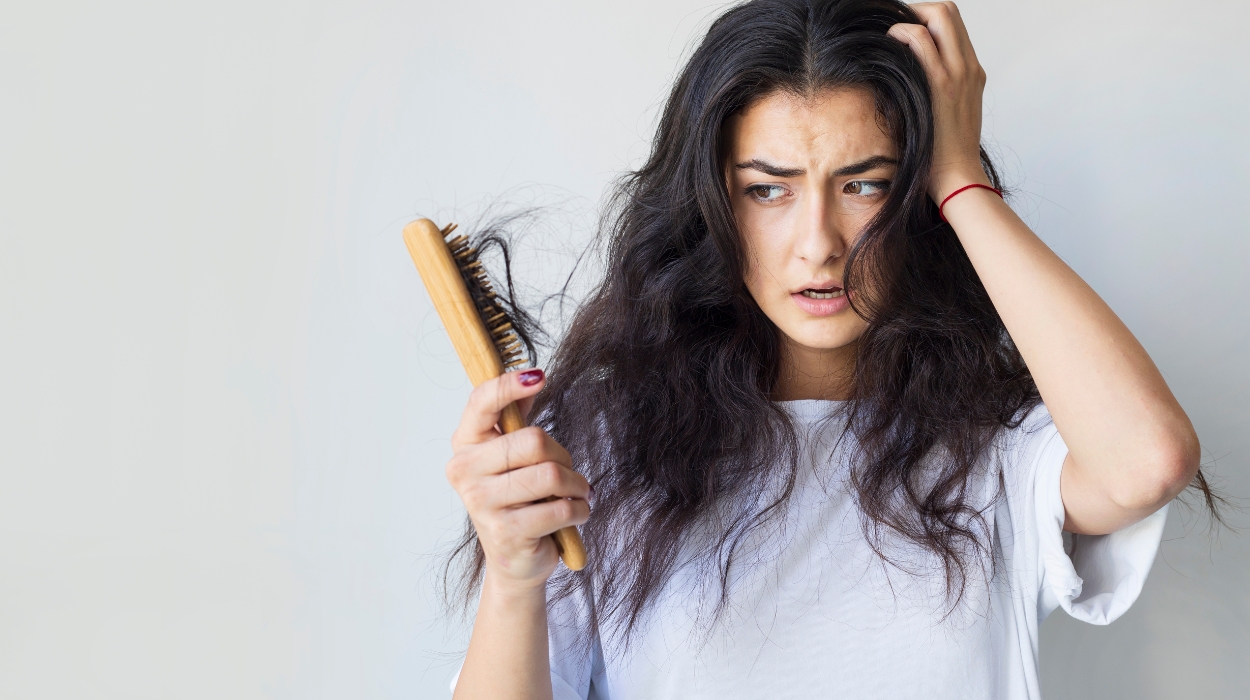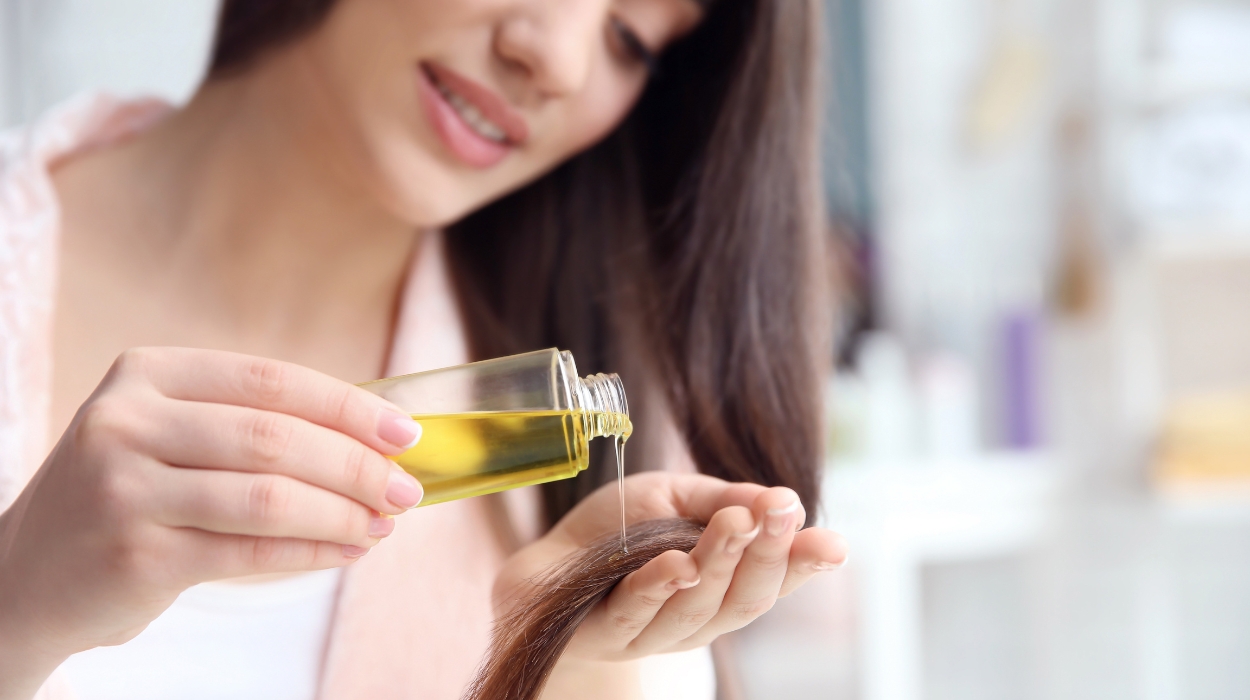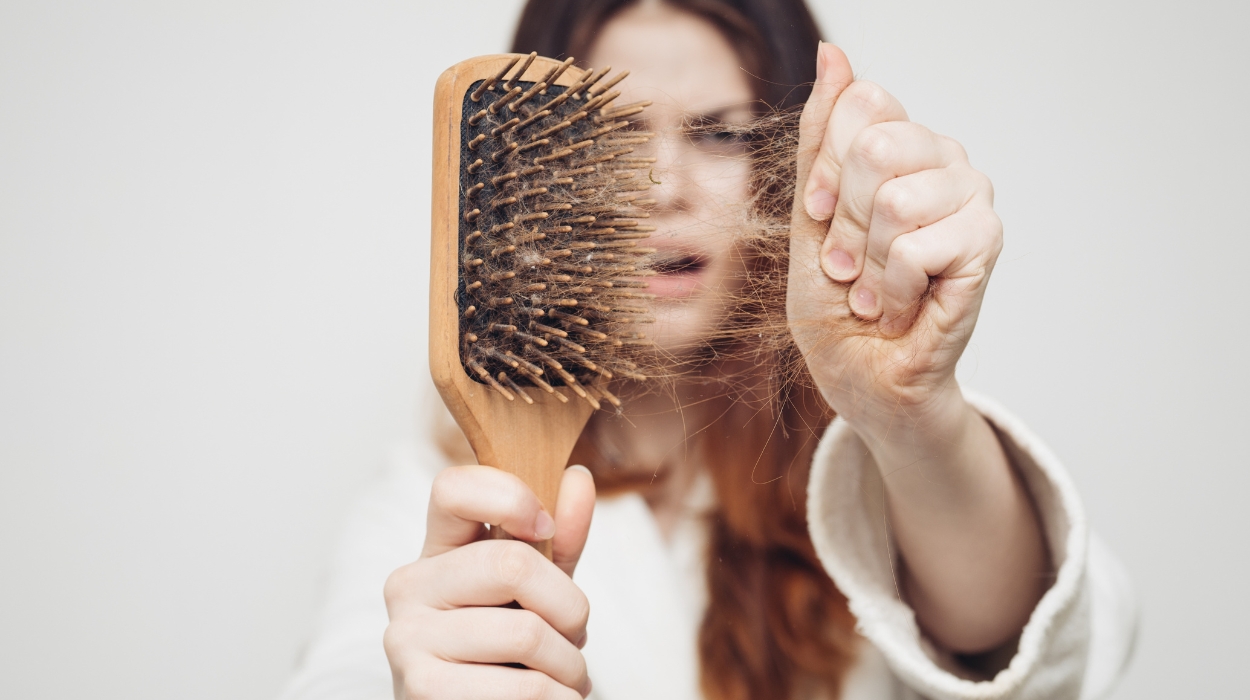 Expert's opinion
Expert's opinion
Expert's opinion
The article is a subjective view on this topic written by writers specializing in medical writing.
It may reflect on a personal journey surrounding struggles with an illness or medical condition, involve product comparisons, diet considerations, or other health-related opinions.
Although the view is entirely that of the writer, it is based on academic experiences and scientific research they have conducted; it is fact-checked by a team of degreed medical experts, and validated by sources attached to the article.
The numbers in parenthesis (1,2,3) will take you to clickable links to related scientific papers.
How To Stop Hair Loss: Causes & Ways To Save Your Hair 2024

While no one wants to lose hair, it happens to a high percentage of people[1] at some point in their lives. Numerous things, including genetics, illness, stress, hormone imbalances, nutritional deficiencies, and age, can cause hair loss.
Hair shedding is sometimes unavoidable, and no one-size-fits-all hair loss cure exists. However, there are some steps you can take to give your hair its best chance to grow. Knowing the causes of hair loss and being proactive in caring for your hair can help save your locks before it’s too late.
Understanding how lifestyle choices, diet, and genetics play a role in hair health is critical in developing a plan to prevent permanent hair loss, using products and hair devices specifically designed for thinning hair, and incorporating scalp massages into your haircare routine to promote healthy hair growth.
How To Prevent Hair Loss: 7 Effective Ways
- Eat a balanced diet rich in vitamins and minerals
- Use the right products for hair
- Manage stress levels
- Avoid tight hairstyles and harsh styling products.
- Protect your scalp from the sun.
- Avoid certain medications that can cause hair loss.
- Reduce DHT levels.
How To Stop Hair Loss And Regrow Hair Naturally

Depending on the cause, it may be possible to slow or treat hair loss and regrow it without a hair transplant. To do this, it is essential to visit a dermatologist or medical hair specialist to understand precisely what is causing the hair loss in order to utilize the proper hair growth treatment. Some key things that might be suggested are:
- Eat a balanced diet rich in vitamins and minerals. This will also help to stop hair loss after weight loss, stress, or pregnancy.
- Use the right products for hair to promote hair growth, such as a dermatologist-recommended shampoo for hair loss.
- Manage stress levels to stop hair loss from stress.
- Avoid tight hairstyles and harsh styling products that can damage the hair shaft.
- Protect your scalp from the sun with hats or sunscreen.
- Avoid certain medications that can cause hair loss.
- Reduce Dihydrotestosterone (DHT) levels medically or with supplements, particularly to help reduce or stop hair loss in men.
How To Reduce Dihydrotestosterone
There are several ways to reduce DHT,[2] a hormone linked to both male and female pattern baldness, to avoid hair loss. The first step is maintaining a healthy diet with fruits, vegetables, and lean proteins. Not only can these foods help keep your hormones balanced, but they also supply the body with essential vitamins and minerals that support healthy hair growth.
Certain supplements may help lower DHT levels.[3] Saw palmetto is a herb that has been shown in some studies to help block the hormone receptors that produce DHT and reduce its production.
Doctors have prescribed medications such as finasteride[4] for men experiencing excessive hair loss due to increased DHT levels. Medications for hair should only be used under the supervision of a healthcare professional after careful consideration of potential risks and benefits.
Scalp Treatments For Hair Loss
There are several scalp treatments available[5] that can stimulate hair growth. A few of the most popular treatments include regular scalp massages, essential oils such as rosemary, lavender, and peppermint, hair devices, low-level laser therapy, and medicated shampoos to eliminate bacteria and fungal conditions on the scalp that may be contributing to temporary hair loss.
Type Of Hair Loss

While there are many potential causes of hair loss, let’s look at some of the most common.
Hormonal Changes
Hormonal changes, for example, during pregnancy and menopause, can significantly impact hair health, leading to female pattern hair loss in some cases.
During pregnancy, increased hormones such as estrogen can cause the hair follicles to remain in the active growing phase longer than usual,[6] resulting in thicker and fuller hair. However, after delivery, these hormone levels drop back to normal or, in the case of breastfeeding, even less than normal. Thus, the hair follicles that had been kept in their active growing phase may enter their resting phase, leading to an excessive shedding of hair, known as postpartum alopecia.
Similarly, during menopause, women experience decreased estrogen levels,[7] which can cause the hair follicles to enter their resting phases sooner than usual. Furthermore, lower estrogen levels can also lead to higher levels of dihydrotestosterone, which contributes to androgenic alopecia or female pattern baldness—a condition characterized by hair thinning but not complete baldness.
Autoimmune Conditions And Illness
Various autoimmune conditions have been linked to hair loss, such as alopecia areata and hypothyroidism.
Alopecia areata[8] is an autoimmune disorder that triggers hair to fall out in round patches. It is thought to be caused by a person’s immune system mistakenly attacking their own hair follicles, leading to sudden and noticeable hair loss.
Hypothyroidism occurs when the thyroid gland underproduces thyroid hormones, which can affect hair growth[9] and lead to thinning or patchy areas of baldness. This is more common in women, and treating the underlying condition may help to stop this form of hair loss in women.
In both cases, the underlying cause of hair loss is an interference with the normal cycle of hair growth and a disruption of the normal functioning of hair follicles that inhibit new hairs from growing back.
COVID-19 has also been linked to hair loss[10] in a stress-related condition called telogen effluvium.[11] COVID-19 can cause hair loss due to a combination of factors, including the effects of the virus on the body, the stress from fever, as well as shifts in hormones and nutrient deficiencies that can occur due to being ill. It is not yet clear how long-lasting this hair loss may be.
Other illnesses such as high fevers, severe infections, or even surgeries may also contribute to the temporary shedding of hair. Still, these usually grow back after hair loss treatment has been completed or the illness has passed.
Medications
Treatments or medications such as chemotherapy and anticoagulants can cause hair loss due to their effects on the body’s normal hair growth cycle.
Chemotherapy targets rapidly dividing cells in the body, which unfortunately includes those found in the scalp and hair follicles.[12] This causes a dramatic disruption of the normal hair growth cycle, leading to excessive shedding of existing hairs.
Blood thinners, i.e., anticoagulants,[13] reduce the amount of clotting factors in the bloodstream, which can impact circulation to the scalp and thereby interfere with healthy hair growth. The exact cause is unknown.
In most cases, hair will grow back once the medication is discontinued.
Hormonal Manipulation
The estrogen in birth control pills extends the anagen, i.e., the growth phase of the hair follicle cycle. Abrupt discontinuation of any drug that prolongs this phase will initiate a premature rest in the telogenic phase, resulting in telogen effluvium. This is the most common cause of drug-induced alopecia. In the question of how to stop hair loss from birth control, just realize this is a temporary problem until the hair follicle re-establishes, which it will do.
Nutrient Deficiencies
Common nutrient deficiencies, such as iron deficiency anemia,[14] protein deficiency,[15] and vitamin D deficiency,[16] can cause hair loss by interfering with the normal growth cycle of hair.
Iron is an essential component in red blood cells that carry oxygen to the cells in the body, including those to the scalp. Without enough iron, the body lacks oxygenated red blood cells to nourish the scalp and help support healthy hair growth.
Protein is another essential nutrient for healthy hair, as it makes up about 90% of a hair strand and is necessary for proper maintenance and growth. Without adequate protein intake, hair growth may slow down or stop altogether.
Vitamin D deficiency has also been linked to alopecia because this vitamin helps activate enzymes that build proteins like keratin, essential components that keep your hair healthy.
Hereditary Causes
Hereditary hair loss includes male and female pattern baldness and autoimmune alopecia areata.[17]
Male pattern baldness[18] has been linked to an excess of dihydrotestosterone, which binds to the hair follicles and prevents them from producing new hair. Genetic predisposition, age-related hormone shifts, and excess DHT production cause female pattern baldness.[19]
Physical Trauma
Other forms of alopecia include traction alopecia, which occurs when hairstyling techniques pull on the scalp excessively; trichotillomania,[20] in which one pulls out their hair; and cicatricial alopecia,[21] which is caused by scarring on the scalp due to injuries or infection. All of these conditions cause thinning or complete loss of hair for varying amounts of time, depending on their severity.
Chemical hair treatments that involve applying harsh chemicals to the hair to change its structure and texture can strip the hair of its natural oils and moisture, making it brittle and prone to breakage.
Stress
Long-term stress has long been known to contribute to hair loss.[22] When a person is under physical or psychological stress, the body goes into fight-or-flight mode, releasing hormones like cortisol and adrenaline, which can have a damaging effect on the hair follicles.[23] Hair follicles are sensitive to these hormones and can enter a resting phase, ceasing hair growth and leading to significant thinning or baldness of the scalp.
Stress-related hair loss can also be caused by trichotillomania, compulsive pulling or twisting of one’s hair due to anxiety, or other psychological distress, leading to excessive hairs being shed. Also, poor nutrition due to improper eating habits brought on by stress or depression can cause nutrient deficiencies that can affect the health of one’s hair.
Lifestyle Factors
Too much sun exposure without adequate protection from sunscreen or hats can lead to UV rays causing inflammation and damaging the scalp.[24] Hair follicles exposed to free radicals and oxidants over an extended period can become vulnerable to damage.
Age
Age is one of the most common contributing factors to hair loss.[25] As people age, their bodies exhibit age-related changes in the scalp and hair follicles, which lead to a decrease in the number of new hair cells that can form and a reduction in hair density, which can result in thinning or balding.
When Should You See A Professional
If you are experiencing dramatic, unexplained hair loss of more than 100 strands per day, it is recommended to see a medical professional as soon as possible. This is especially true if hair loss is accompanied by changes in scalp texture and decreased scalp elasticity.
Suppose the hair loss is accompanied by other symptoms such as itching, burning, or scalp redness. In that case, it may indicate an underlying infection or a serious autoimmune condition such as alopecia areata.
The Bottom Line
Hair loss is a common condition affecting both men and women worldwide. By understanding its causes and the potential ways to save your hair, you can take proactive steps to stop it.
Genetics, hormones, or age are all possible factors, but lifestyle choices such as poor nutrition, stress, and certain medications can also contribute.
The best way to boost hair regrowth and slow hair loss is to practice a healthy lifestyle, with a balanced diet rich in vitamins and minerals, regular exercise and relaxation techniques, and seek medical advice for those more serious cases.
+ 25 sources
Health Canal avoids using tertiary references. We have strict sourcing guidelines and rely on peer-reviewed studies, academic researches from medical associations and institutions. To ensure the accuracy of articles in Health Canal, you can read more about the editorial process here
- Guo, E. and Katta, R. (2017). Diet and hair loss: effects of nutrient deficiency and supplement use. Dermatology practical & conceptual, [online] pp.1–10. doi:https://doi.org/10.5826/dpc.0701a01.
- Izabela Urysiak-Czubatka, Kmieć, M.L. and Grażyna Broniarczyk-Dyła (2014). Assessment of the usefulness of dihydrotestosterone in the diagnostics of patients with androgenetic alopecia. Postepy Dermatologii I Alergologii, [online] 4, pp.207–215. doi:https://doi.org/10.5114/pdia.2014.40925.
- Sumel Ashique, Navjot Kaur Sandhu, Sk. Niyamul Haque and Koley, K. (2020). A Systemic Review on Topical Marketed Formulations, Natural Products, and Oral Supplements to Prevent Androgenic Alopecia: A Review. Natural Products and Bioprospecting, [online] 10(6), pp.345–365. doi:https://doi.org/10.1007/s13659-020-00267-9.
- Medlineplus.gov. (2022). Finasteride: MedlinePlus Drug Information. [online] Available at: https://medlineplus.gov/druginfo/meds/a698016.html.
- Wall, D., Meah, N., Fagan, N., York, K. and Sinclair, R. (2022). Advances in hair growth. Faculty reviews, [online] 11. doi:https://doi.org/10.12703/r/11-1.
- Motosko, C.C., Amy Kalowitz Bieber, Miriam Keltz Pomeranz, Stein, J.A. and Martires, K.J. (2017). Physiologic changes of pregnancy: A review of the literature. International Journal of Women’s Dermatology, [online] 3(4), pp.219–224. doi:https://doi.org/10.1016/j.ijwd.2017.09.003.
- Grymowicz, M., Rudnicka, E., Agnieszka Podfigurna, Napierała, P., Smolarczyk, R., Katarzyna Smolarczyk and Błażej Męczekalski (2020). Hormonal Effects on Hair Follicles. International Journal of Molecular Sciences, [online] 21(15), pp.5342–5342. doi:https://doi.org/10.3390/ijms21155342.
- Darwin, E., Hirt, P.A., Fertig, R., Doliner, B., G.M. DelCanto and Jiménez, J.J. (2018). Alopecia areata: Review of epidemiology, clinical features, pathogenesis, and new treatment options. International Journal of Trichology, [online] 10(2), pp.51–51. doi:https://doi.org/10.4103/ijt.ijt_99_17.
- Popa, A., Cârșote, M., Dragoș Crețoiu, Mihai Cristian Dumitraşcu, Nistor, C. and Florica Şandru (2023). Study of the Thyroid Profile of Patients with Alopecia. Journal of Clinical Medicine, [online] 12(3), pp.1115–1115. doi:https://doi.org/10.3390/jcm12031115.
- Shahram Seyfi, Robabeh Alijanpour, Zeinab Aryanian, Khadijeh Ezoji and Mahmoudi, M. (2022). Prevalence of telogen effluvium hair loss in COVID-19 patients and its relationship with disease severity. Journal of medicine and life, [online] 15(5), pp.631–634. doi:https://doi.org/10.25122/jml-2021-0380.
- Asghar, F., Shamim, N., Umar Farooque, Sheikh, H. and Aqeel, R. (2020). Telogen Effluvium: A Review of the Literature. Cureus. [online] doi:https://doi.org/10.7759/cureus.8320.
- Lee, T.-J., Kang, H., Berry, J.C., Joo, H., Park, C., Miller, M.J. and Choi, K. (2021). ER71/ETV2 Promotes Hair Regeneration from Chemotherapeutic Drug-Induced Hair Loss by Enhancing Angiogenesis. Biomolecules & Therapeutics, [online] 29(5), pp.545–550. doi:https://doi.org/10.4062/biomolther.2021.022.
- Watras, M., Patel, J.P. and Arya, R. (2016). Traditional Anticoagulants and Hair Loss: A Role for Direct Oral Anticoagulants? A Review of the Literature. Drugs – Real World Outcomes, [online] 3(1), pp.1–6. doi:https://doi.org/10.1007/s40801-015-0056-z.
- Yulia Treister-Goltzman, Shaked Yarza and Peleg, R. (2021). Iron Deficiency and Nonscarring Alopecia in Women: Systematic Review and Meta-Analysis. Skin appendage disorders, [online] 8(2), pp.83–92. doi:https://doi.org/10.1159/000519952.
- Guo, E. and Katta, R. (2017). Diet and hair loss: effects of nutrient deficiency and supplement use. Dermatology practical & conceptual, [online] pp.1–10. doi:https://doi.org/10.5826/dpc.0701a01.
- Agnieszka Gerkowicz, Katarzyna Chyl-Surdacka, Dorota Krasowska and Grażyna Chodorowska (2017). The Role of Vitamin D in Non-Scarring Alopecia. International Journal of Molecular Sciences, [online] 18(12), pp.2653–2653. doi:https://doi.org/10.3390/ijms18122653.
- NIAMS (2017). Alopecia Areata. [online] National Institute of Arthritis and Musculoskeletal and Skin Diseases. Available at: https://www.niams.nih.gov/health-topics/alopecia-areata.
- Heilmann‐Heimbach, S., Hochfeld, L.M., Henne, S. and Nöthen, M.M. (2020). Hormonal regulation in male androgenetic alopecia—Sex hormones and beyond: Evidence from recent genetic studies. Experimental Dermatology, [online] 29(9), pp.814–827. doi:https://doi.org/10.1111/exd.14130.
- Yasmeen Jabeen Bhat, Saqib, N.-U., Latif, I. and Hassan, I. (2020). Female pattern hair loss—An update. Indian Dermatology Online Journal, [online] 11(4), pp.493–493. doi:https://doi.org/10.4103/idoj.idoj_334_19.
- Grant, J.E. (2019). Trichotillomania (hair pulling disorder). Indian Journal of Psychiatry, [online] 61(7), pp.136–136. doi:https://doi.org/10.4103/psychiatry.indianjpsychiatry_529_18.
- Filbrandt, R., Rufaut, N.W., Jones, L. and Sinclair, R. (2013). Primary cicatricial alopecia: diagnosis and treatment. Canadian Medical Association Journal, [online] 185(18), pp.1579–1585. doi:https://doi.org/10.1503/cmaj.111570.
- Eva M.J. Peters, Müller, Y., W. Snaga, Fliege, H., Anett Reißhauer, Schmidt‐Rose, T., Max, H., Schweiger, D., Rose, M. and Kruse, J. (2017). Hair and stress: A pilot study of hair and cytokine balance alteration in healthy young women under major exam stress. PLOS ONE, [online] 12(4), pp.e0175904–e0175904. doi:https://doi.org/10.1371/journal.pone.0175904.
- Hasan, R., Juma, H., Eid, F.A., Alaswad, H.A., Ali, W.M. and Aladraj, F.J. (2022). Effects of Hormones and Endocrine Disorders on Hair Growth. Cureus. [online] doi:https://doi.org/10.7759/cureus.32726.
- Gherardini, J., Wegner, J., Jérémy Chéret, Sushmita Ghatak, Lehmann, J., Alam, M., Jiménez, F., Funk, W., Böhm, M., Botchkareva, N.V., Ward, C., Paus, R. and Bertolini, M. (2019). Transepidermal UV radiation of scalp skin ex vivo induces hair follicle damage that is alleviated by the topical treatment with caffeine. International Journal of Cosmetic Science, [online] 41(2), pp.164–182. doi:https://doi.org/10.1111/ics.12521.
- Trüeb, R.M., Hudson Dutra Rezende and Fernanda, M. (2018). A comment on the science of hair aging. International Journal of Trichology, [online] 10(6), pp.245–245. doi:https://doi.org/10.4103/ijt.ijt_56_18.



